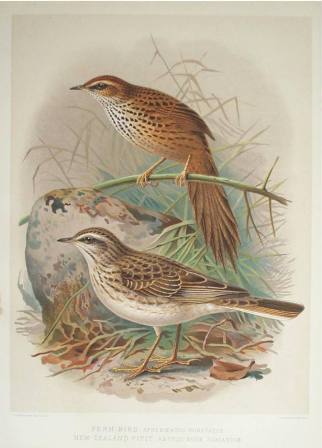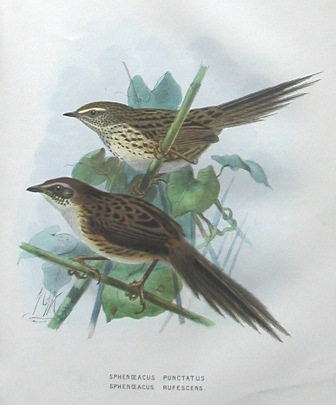
On a recent field trip to Ohiwa Harbour with friends from the New Zealand Ornithological Society I became distracted by the call of Matata, the fernbird. I don’t very often get the opportunity to see the fernbird since there are none here in my valley. I must have spent more than half an hour watching them which leads me to the conclusion that bird watching is another form of meditation.
The fernbird’s habitat on the Ohiwa spit seems so unpromising for any bird, just a relatively small patch of gorse, pampas grass, rushes, and what look like ngaio trees, although there is some suspicion they may be Tasmanian imports. With a housing settlement nearby, one would think they would be especially vulnerable to predators but here they are squeaking away and easily attracted, as my expert friends tell me, by a rough imitation of their call. These birds are old hat to them. They are much more interested in godwits, dotterels and the finer points of identifying terns.
The literature tells me that the fernbird is found nowhere else in the world but New Zealand, so is endemic and fully protected. Their main habitats are low dense ground vegetation interspersed with emergent shrubs in drier swamps, pakahi, rush and tussock covered saltmarsh, low manuka scrub and some young pine plantations from sea level to around 1,000m.
Most fernbirds stay in pairs or small groups all year. Their flight is very weak and their calls reveal their presence. They are secretive, but inquisitive and will poke their heads out from for a moment and then disappear again. They are reluctant to leave cover but when forced they fly low with their tail hanging down. As they are such weak fliers, they are particularly vulnerable should fire occur in their habitat, an occurrence which is not infrequent. Some years ago, the Whangamarino Swamp in the Waikato was burned off in a feud between marijuana growers, resulting in the death of approximately one third of the 9,000 fernbirds in the swamp, as estimated by the Department of Conservation.
In spring the birds are much noisier because of territorial disputes. Both birds work together to make the nest. It is a neatly woven cup of dry grass, sedge and rushes, generally lined with feathers and is placed deep in cutty grass rushes or tussock just above the ground or just above water level, but occasionally in a small shrub up to 2m off the ground.
Guthrie–Smith waxes lyrical about the eggs of the fernbird: “the eggs are really beyond imagination lovely, most elegant in shape, frail, of a diaphanous pink spotted with dots of brown, innumerable as stars in clear darkness, freckles on a fair beauty’s face, their shell too exquisite indeed for rude, human touch, treasure fit only to lie in a fairy princess’s palm, to be brushed by her lips, to be lovingly pressed to a bosom smnooth and warm as the soft feathers of the mother bird.”
Both parents feed the chicks.
The birds feed mainly on caterpillars, spiders, grubs, beetles, flies and moths, in vegetation or on the ground. After becoming independent juveniles roam away from their natal territory and can turn up in small scrub patches and wetlands 20 or more km away from nearest breeding birds.
The Maori, according to Elsdon Best, called the fernbird Toetoe, Kukurutoki, or Mata and looked upon it as manu tohu, a wise bird, the cries of which contained warnings of coming events, of future success or ill fortune. Its ordinary cry of Te, te, te, does not appear to have contained a message, but when it cries Kore ti, kore ti, then all know it is a puhore; whatever project may be on hand at the time will be a failure. When the cry changes to Tori ki, toro ki, toro ki, kuri, kuri, then know it is a token of good fortune.

Other common names: —
Utick bird.
Description: —
Endemic bird
18 cm., 35 g., brown above, paler brown below, heavily streaked and spotted dark brown, forehead and crown chestnut, white eyebrow stripe.
Where to find: —
In the North Island they are distributed in patches from the Manawatu Estuary north. In the South Island, they are common west of the Alps, Stewart, Codfish, Snares Islands.
Illustration description: —
Buller, Walter Lawry, Birds of New Zealand, 1888.
Buller, Walter Lawry, Birds of New Zealand, 1873.
Reference(s): —
Heather, B., & Robertson, H., Field Guide to the Birds of New Zealand, 2000.
Oliver, W.R.B. New Zealand Birds, 1955.
Guthrie-Smith, H., Mutton Birds and Other Birds, 1914.
Page date & version: —
Wednesday, 28 May 2014; ver2009v1

